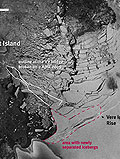The recent collapse of a vital buttress in Antarctica’s Wilkins Ice Shelf is now leading to the fracturing of large icebergs from the massive floating ice sheet, according to recent satellite photos from the European Space Agency. The pictures show that since the disintegration of a 25-mile-long ice bridge on April 2, icebergs equaling the size of New York City have split off from the ice shelf and floated into a nearby bay. The image, captured by the space agency’s Envisat satellite, shows the area — outlined in pink — where icebergs have calved from the northern end of the Wilkins Ice Shelf since the disintegration of the ice bridge that had connected the shelf to Charcot Island. The area once occupied by the ice bridge is outlined in white. Rapidly rising temperatures along the Antarctic Peninsula, where the Wilkins Ice Shelf is located, have led to the full or partial breakup of 10 ice shelves in recent decades. The Envisat image shows scores of other icebergs that have broken off recently from the shelf.
Wilkins Breakup Continues
More From E360
-
WATER
After Ruining a Treasured Water Resource, Iran Is Drying Up
-
FILM
At a Marine Field Station, Rising Seas Force an Inevitable Retreat
-
Energy
To Feed Data Centers, Pennsylvania Faces a New Fracking Surge
-
SPACE
Scientists Warn of Emissions Risks from the Surge in Satellites
-
WILDLIFE
A Troubling Rise in the Grisly Trade of a Spectacular African Bird
-
MINING
In Myanmar, Illicit Rare Earth Mining Is Taking a Heavy Toll
-
INTERVIEW
How Batteries, Not Natural Gas, Can Power the Data Center Boom
-
ANALYSIS
As U.S. and E.U. Retreat on Climate, China Takes the Leadership Role
-
Solutions
From Ruins to Reuse: How Ukrainians Are Repurposing War Waste
-
ANALYSIS
Carbon Offsets Are Failing. Can a New Plan Save the Rainforests?
-
Energy
Facing a Hostile Administration, U.S. Offshore Wind Is in Retreat
-
Biodiversity
As Jaguars Recover, Will the Border Wall Block Their U.S. Return?
